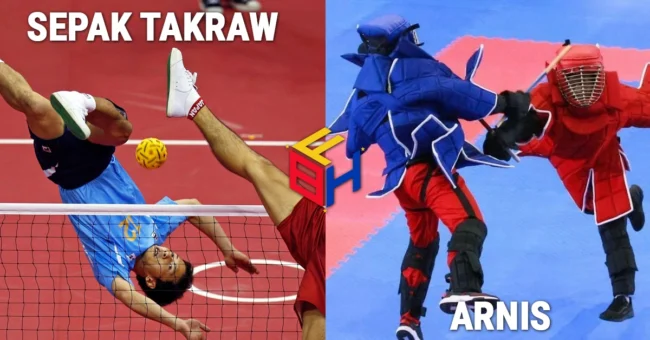Sipa and Arnis: Pambansang Laro ng Pilipinas
The Philippines, like many other countries, has a national game or sport that symbolizes its unique culture and heritage. Known as “Pambansang Laro ng Pilipinas” in the Filipino language, the national sport is essential to the country’s identity and spirit.
Having a national sport is crucial for several reasons. It promotes physical activity and a healthy lifestyle, encourages teamwork and friendly competition, and helps preserve traditional games and sports that are part of a country’s cultural heritage.
The Philippines has two recognized national sports: Sipa and Arnis. Sipa was the country’s national game until 2009, when Gloria Macapagal Arroyo, the former President of the Philippines, declared Arnis the official National Sport of the Philippines.

Sipa as the Former Pambansang Laro ng Pilipinas
Origins and History of Sipa
Sipa is a traditional Filipino game involving a shuttlecock made of rattan or other materials being kicked around by players using their feet, knees, or any other body except their hands. The game’s origins can be traced back to pre-colonial times when indigenous tribes played it as a form of entertainment and exercise.
Description of the game and how it is played
The game of Sipa is played on a rectangular court divided by a net. Each team consists of two to four players who try to keep the shuttlecock in the air as long as possible by kicking it over the net to the other side. The objective is to make the shuttlecock touch the ground on the opponent’s courtside. The team that successfully does so scores a point. The game is typically played to 21 points, with the team that reaches the target score first being declared the winner.
Cultural Significance of Sipa in the Philippines
Sipa is an essential part of Philippine culture and has been played for centuries by people of all ages and backgrounds. The game is not only a fun and exciting activity but also promotes physical fitness, teamwork, and sportsmanship. Sipa has been played in various forms throughout Southeast Asia, and its popularity has spread to other parts of the world as well.
Recognition of Sipa as the former Pambansang Laro ng Pilipinas
For many years, Sipa was recognized as the Pambansang Laro ng Pilipinas or the national sport of the Philippines. However, in 2009, then-President Gloria Macapagal Arroyo declared that Arnis would be the official national sport of the Philippines, replacing Sipa.
Arnis as the Current Pambansang Laro at Pananandata ng Pilipinas
Origins and History of Arnis
Arnis (or Kali or Eskrima in Filipino) is a martial art from the Philippines that emphasizes using weapons like sticks, knives, and bladed weapons in combat situations. Its origin can be traced back to indigenous tribes of the Philippines who used it as self-defense against foreign invaders.
Arnis was prohibited under Spanish colonial rule, yet still practiced underground by individuals and groups who practiced the art secretly. However, after its rediscovery by practitioners showcasing it publicly during public demonstrations and tournaments in the 20th century, its popularity surged again.
Description of the Martial Art and How it is Practiced
Arnis is an adaptable martial art that can be practiced either with weapons or empty hands, with a particular focus on footwork, body movement, coordination; timing, and strategy; as well as “flow,” or the ability to seamlessly transition between techniques and movements.
Arnis practitioners start out learning basic strikes, blocks, and footwork before progressing to more complex techniques and combinations. Once adept, practitioners may incorporate weapons such as swords, spears, or even unconventional objects into their training regime.
Cultural Significance of Arnis in the Philippines
Arnis is integral to Philippine culture and history, reflecting both independence and resistance against foreign dominance. Furthermore, its development demonstrates Filipino people’s resourcefulness despite limited resources – they were able to craft a sophisticated martial art with limited means.
Arnis is recognized as an effective means to foster unity and camaraderie among Filipinos, as it is a shared cultural heritage that brings them together. Furthermore, Arnis has also become an effective way of encouraging physical fitness and self-discipline among young people – an invaluable educational opportunity!
Recognition of Arnis as the National Martial Art and Sport of the Philippines
In 2009, President Gloria Macapagal-Arroyo designated Arnis as the national martial art and the sport of the Philippines, replacing Sipa as Pambansang Laro ng Pilipinas. This declaration demonstrated Arnis’ growing prominence within its home country and beyond its borders.
Arnis has since been included in major international sporting events such as the Southeast Asian Games, where Filipino athletes have received multiple medals.
Significance of Sipa and Arnis as Pambansang Laro ng Pilipinas
Contribution of Sipa and Arnis to Philippine Culture and Identity
Sipa and Arnis are significant symbols of Philippine culture and identity, representing its creativity, resilience, resourcefulness, and passion for sports and physical activity.
By hosting these national games, the Philippines can showcase its rich cultural heritage to the rest of the world while simultaneously instilling pride and patriotism within its people.
Promotion of physical fitness and healthy competition
Sipa and Arnis promote physical fitness and healthy competition that contribute to Filipino well-being. In addition, by encouraging participation in sports and physical activity, these national games may help decrease chronic diseases or other health complications that arise among their participants.
They can also help develop essential life skills like teamwork, perseverance, and goal setting that can be applied in other aspects of life.
Economic and Tourism Potential of Sipa and Arnis
Sipa and Arnis provide substantial economic and tourism potential for the Philippines. In addition, both can attract visitors from around the globe interested in traditional Filipino sports and martial arts.
